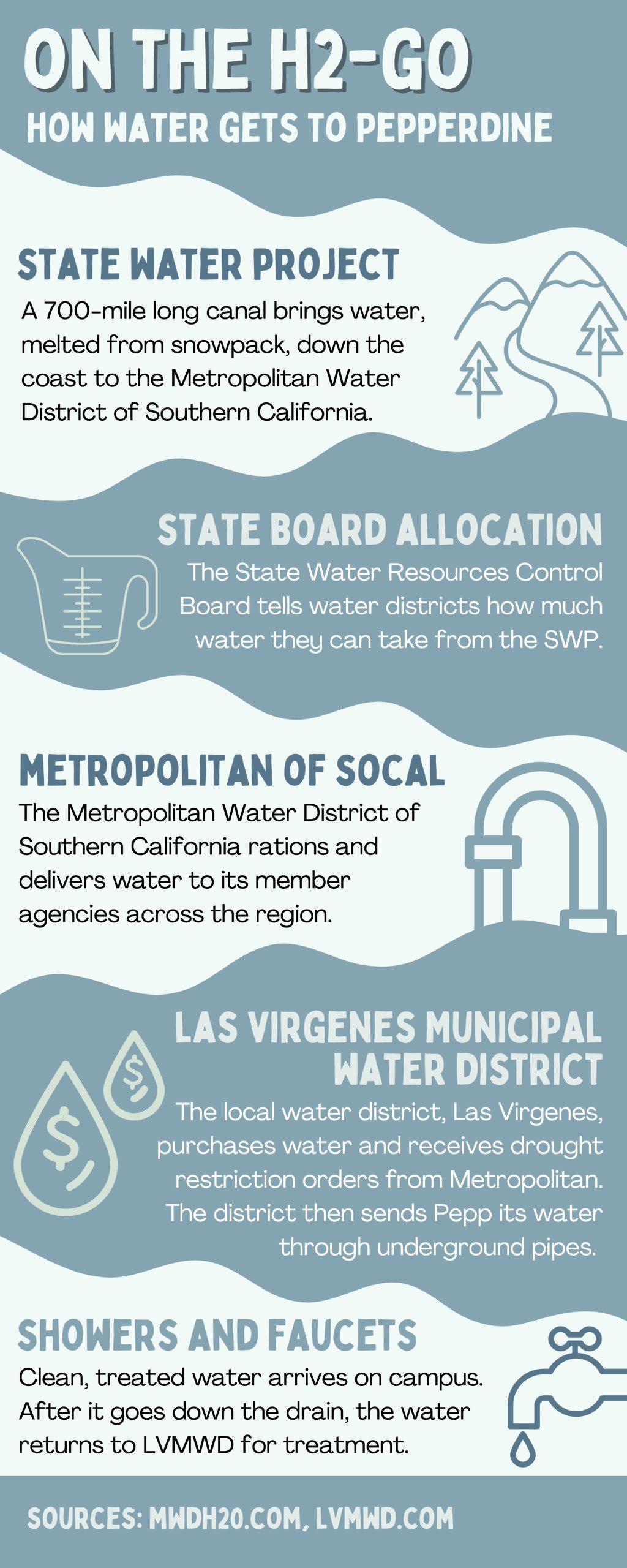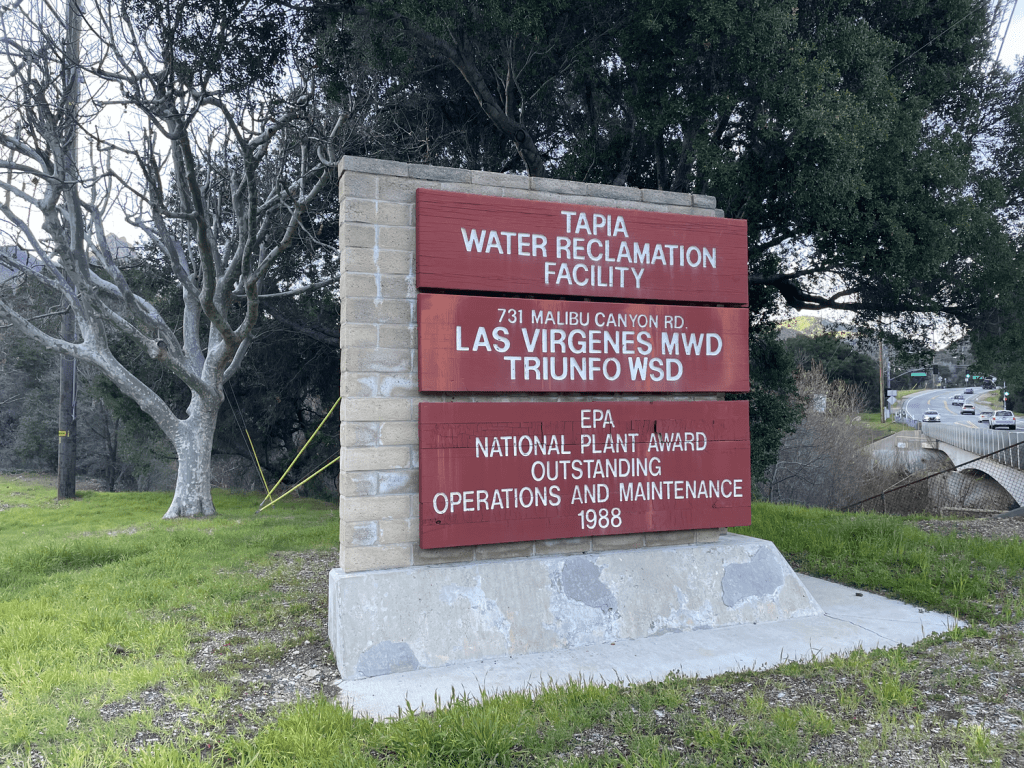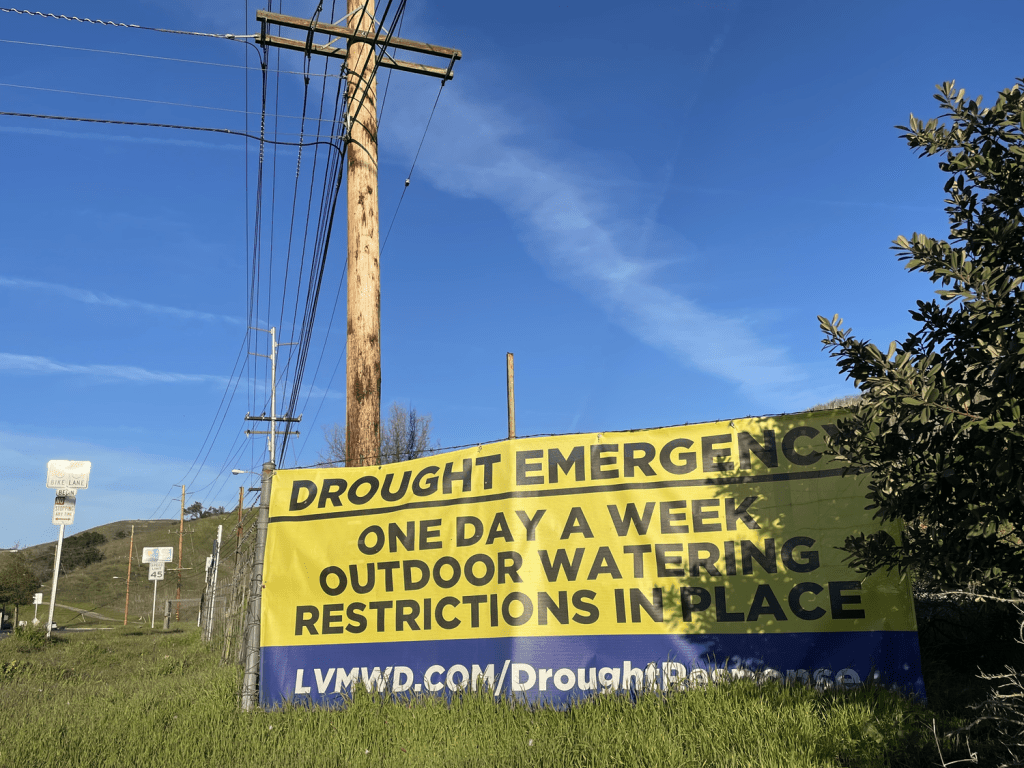A drought emergency banner hangs on a fence post at the intersection of Lost Hills Road and Malibu Canyon Road in Calabasas, Calif., on Feb. 4. After the State Water Resources Control Board allocated 5% to the Las Virgenes Municipal Water District, the LVMWD enacted a water restriction that restricted their residents to water one day a week. Photos by Ali Levens
With native groundwater long gone due to extreme droughts in the past decade, the Las Virgenes area — including Pepperdine — must import 100% of its drinking water, according to the Las Virgenes Municipal Water District’s (LVMWD) website.
Importing water — and deciding who gets how much — involves the legal coordination of water districts and state governments to ensure this resource does not run dry.
“That’s the problem I see with water, is that people view it as a property right, something that they’re entitled to,” said Shelley Saxer, Caruso School of Law Environmental Law professor.
People, organizations or governments can hold a form of property rights for water, known as senior water rights or prior appropriation, Saxer said. Prior appropriation for water recognizes the first entity to use a water source has precedence in its usage.
Prior appropriation grants legal permission to California and its water districts to implement water rationing laws and restrictions while it is in a drought state of emergency, Saxer said. For the ongoing drought state of emergency, Government Code section 11346.1 and Water Code section 1058.5 give California and its water board this authority, according to California Water Boards.
The Metropolitan Water District of Southern California collects and rations water to its 26 member agencies and 19 million residents, said Demetri Polyzos, resource planning team manager at Metropolitan.
Polyzos said the water district imports about half of its water from the State Water Project and the Colorado River Basin, with the other half supplied via groundwater or recycled water at the other agencies.
For the second-consecutive year, the State Water Resources Control Board announced water districts would receive an allocation of 5% from the State Water Project, Polyzos said. This led Metropolitan to enact water restrictions on districts with smaller populations that receive most of their water from the State Water Project, which includes Pepperdine’s water supplier, the LVMWD.
“It’s [water allocation] virtually nothing,” said Mike McNutt, LVMWD public affairs and communications manager.

Polyzos said the Board’s low allocation “puts a strain” on the available water held in storage. Consequently, there is not enough water coming from the Board to satisfy Metropolitan’s water needs through allocation alone.
“That wasn’t enough,” Polyzos said. “That’s when we had to start essentially restricting.”
The restrictions for the LVMWD came in the form of limiting outdoor water usage by volume or by frequency starting in June 2022, McNutt said. LVMWD chose to limit outdoor watering to one day a week.
McNutt said the district chose the frequency approach because the volumetric restriction would require residents to reduce their water use by 73% — something McNutt said would “never” happen — and because frequency restrictions are “easier” to enforce.
Metropolitan requires the LVMWD to report its compliance monthly with the approved district-wide water reduction plan, McNutt said. If the LVMWD does not stay at or below the agreed upon water supply, Metropolitan will fine the water agency, which can be “quite substantial.”
In terms of outdoor watering at Pepperdine, the LVMWD and Pepperdine have a partnership with sending and receiving water. McNutt said Pepperdine sends its sewage to LVMWD’s Tapia Water Reclamation Facility, where it is treated and then sent back as “purple pipe water.” The University then uses this reclaimed water to keep Alumni Park green.

To stave off further restrictions, Polyzos said Metropolitan prepares four different scenarios of what could potentially happen to the water supply and demand — whether a surplus or drought — as part of a 25-year outlook.
“A lot of what changes among those scenarios is different assumptions on what the climate is doing, because that will have a big impact on our water supply,” Polyzos said. “We’re already seeing that today. So, we are planning for climate change impacts, and so that’s baked into our long-term planning.”
Polyzos and McNutt said there has been a shift in the mindset of Californians’ relationship with conserving water. Polyzos said the data backs that up, because even with a 5 million resident increase in Southern California in the 1980s, water usage has been stable, which shows the individual Californian uses less water now than they did three decades ago.
“There is a major sense of urgency associated with finding additional water supplies to get us through, but [this] arguably, is the new normal,” McNutt said.
McNutt said the 15% allocation is the minimum an agency should receive to cover health and safety needs, but the Board increased the allocation to 30% after record rainfall filled reservoirs across the state.
“Our supplies are increasing this year, but we can’t let off the gas, with respect to continuing to find ways to save water, to use it wisely,” Polyzos said. “What we do in these wetter periods makes a huge difference in how we can manage the drier period, so we always need to keep conserving.”
___________________
Follow the Graphic on Twitter: @PeppGraphic
Contact Ali Levens via Instagram (@journ.ali.sm) or by email: ali.levens@pepperdine.edu

